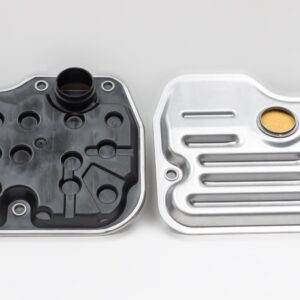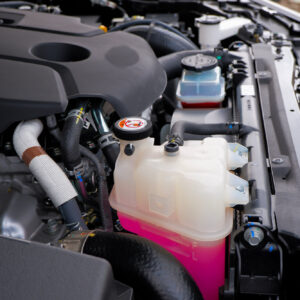Without a fully functioning transmission, your vehicle wouldn’t be able to go anywhere. Keeping your transmission fluid in check and changing it whenever necessary can help keep your transmission up and running.
When it comes to transmission fluid maintenance, you basically have two options. You can either flush your transmission fluid or do a transmission fluid change.
What’s the Difference Between a Transmission Fluid Flush and a Transmission Fluid Change?
Both of these procedures involve replacing the transmission fluid. The main difference is that a transmission fluid flush involves using specialized equipment to completely flush out old fluid and contaminants from your transmission system. Meanwhile, a transmission fluid change involves draining your transmission fluid from the drain plug and replacing it with new fluid.
A fluid flush basically replaces about 90% of the transmission fluid. Meanwhile, a fluid change will replace less than 50% of the fluid.

The Basics of a Transmission Fluid Flush
During a transmission fluid flush, a specialized machine pumps a cleaning solution through the cooler lines.
Since this is a more complex process compared to a transmission fluid change, it’s best to let a trained technician at a reputable automotive repair shop do this procedure.
Benefits of a Transmission Flush
Here are the advantages of doing a transmission flush:
Comprehensive Cleaning
Although both procedures can replace old transmission fluid, you can expect a more thorough cleaning with a transmission flush. That’s because a flush involves using a flush additive to help clean dirt and accumulated sludge inside your transmission.
Improved Performance
Transmission fluid will flow properly if you effectively remove debris, sludge, and other contaminants. This can result in smoother shifting and improved vehicle performance.
Prolonged Lifespan
Flushing your transmission regularly will help you make the most out of your vehicle’s lifespan. The procedure will help extend the life of crucial transmission components. You’ll experience fewer transmission issues if you follow your ride’s transmission maintenance schedule.
What Are the Cons of Doing a Transmission Fluid Flush?
While a transmission fluid flush offers a lot of benefits, this procedure also has some drawbacks. Here are some things to consider:
Risk of Transmission Damage
Doing a transmission flush is generally safe. However, in some instances, fluid can flow in another direction, potentially dislodging debris that has already settled. This debris can go to other areas, leading to clogs and damage inside the transmission.
Cost
A transmission fluid flush is more costly compared to a transmission fluid change. To do a flush, you’ll need to pay to use the specialized flushing equipment on top of labor and materials.

Should I Get a Transmission Flush or Change?
You’ll have to consider many factors when deciding whether to flush your transmission or opt for a transmission fluid change. There’s really no straightforward answer to this question. You’ll have to check your ride’s maintenance history and the condition of your transmission fluid.
Remember that a transmission fluid flush offers a more comprehensive cleaning procedure. However, it is more expensive than a fluid change.
If you’re confused about which procedure to do after considering all these factors, you can ask a trusted mechanic for advice. You can also check your car manufacturer’s recommendations.
It will also help if you review your owner’s manual. This manual will usually give you an idea of how often you should change your transmission fluid and which type of fluid to use.
Signs You Need to Change Your Transmission Fluid
Automatic transmission fluid usually lasts anywhere between 60,000 and 100,000 miles. You can look at your owner’s manual for the specific interval recommendation for your make and model.
Some symptoms may also suggest that your vehicle needs a transmission fluid change. Aside from checking the condition of your transmission fluid, you should observe how your transmission shifts. Watch out for strange noises like whining or grinding. Bring your vehicle to a shop right away if you have difficulty changing or shifting gears.
How Much Does It Cost to Do a Transmission Flush?
Expect to spend around $150 to $400 for a transmission flush. You’ll need to consider your ride’s make and model, your transmission’s total-fill capacity, and the cost of the transmission fluid. You’ll also have to consider the current labor rates in your area.
How Much Does It Cost to Do a Transmission Fluid Change?
If you choose to get a transmission fluid change, expect to spend around $150 to $175. The prices will also depend on many factors like the condition of your fluid and transmission.
If a mechanic detects contamination anywhere within the system, expect to shell out more money for repairs.
Importance of Transmission Maintenance
Regular maintenance is important to ensure your vehicle runs smoothly. Whether you opt for a transmission flush or fluid change, staying on top of recommended service intervals and using the correct automatic transmission fluid for your vehicle is essential.
By not delaying transmission maintenance, you can minimize the risk of costly repairs and maximize the lifespan of your daily driver.
Where to Get New Automatic Transmission Fluid
Because transmission fluid naturally wears over time, you’ll have to change it at some point. Refusing to do so can lead to increased friction between transmission components, leading to some costly repairs. It’s best to avoid driving your vehicle until you replace your dirty transmission fluid. Thankfully, getting brand-new transmission fluid is fast and easy with CarParts.com.
CarParts.com offers a wide selection of automatic transmission fluids, all sourced from only the most trusted manufacturers in the industry. Enjoy a worry-free shopping experience, thanks to our 60-day return policy. If for some reason you aren’t completely satisfied with your order, we accept returns within 60 days. Just reach out to our friendly customer service staff, who are more than happy to help.
Don’t wait until dirty transmission fluid interferes with your coolant system before flushing or changing it. Check out our catalog of high-quality automatic transmission fluids at CarParts.com and order today!
Any information provided on this Website is for informational purposes only and is not intended to replace consultation with a professional mechanic. The accuracy and timeliness of the information may change from the time of publication.
































